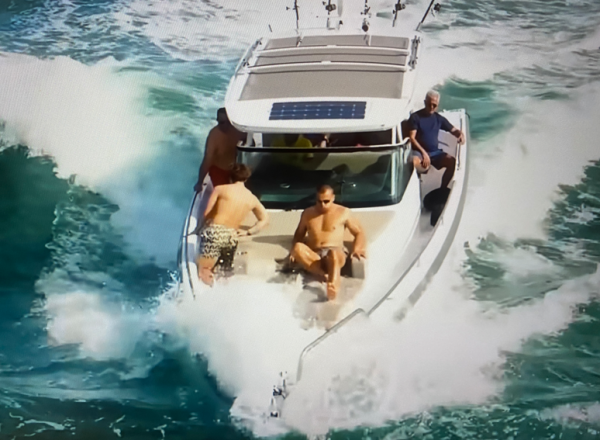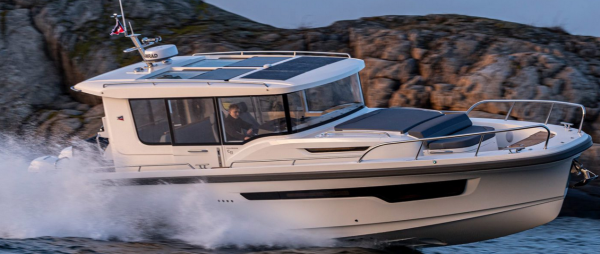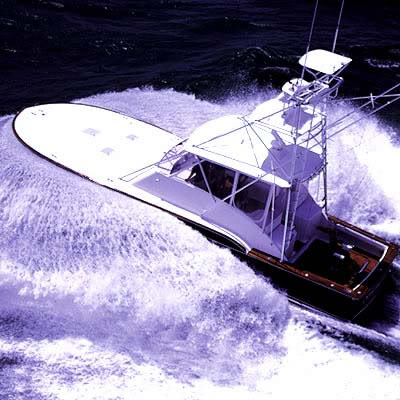
The amazing Bronco’s Guru footage from Haulover Inlet this week showing one of the Nordic style boats now in vogue—in this case an Axopar--running through steep seas is an eye opener for anglers and powerboat cruising fans looking for a boat suitable for operation in coastal areas.
In a nutshell, on this particular footage—see it here—this type of boat does not look good attempting Haulover Inlet on the north side of Miami.
The narrow beam and knife-like bow of the Nordic boats (Nimbus, Aquador and Quarken are similar) has made them a favorite for running moderately rough seas as well as for plenty of speed on minimal power—or conversely lots of range on minimal fuel.
They go through a chop like a knife, and can be powered with smaller outboards than are necessary for typical wide-beamed U.S. designs that have lots of freeboard and flare up front. The result is more range and/or better fuel economy. They’re designed for rivers, bays and sounds, anywhere there’s not the likelihood of extreme seas, also as “tenders” for large yachts to haul supplies and guests back and forth in the harbor or nearshore.
The designers and engineers of these boats have also added some innovative touches like gull-wing doors opening the upfront cabin to light and air, and fully enclosed, air-conditioned pilothouses where the center console stands in most U.S. designs.
But the sleek appearance and narrow bottom also makes them risky in really rough water where the seas may be taller than the relatively low bow of these designs.
If you boat in an area like much of the east coast or the northwest coast of the U.S., where ocean access nearly always requires running an inlet where all the water from the inshore bays and sounds comes ripping out on tide changes, boats of the Nordic style may not be the best bet unless you are a seasoned and smart skipper used to handling tricky situations on the water. (Alternatively, if you do your boating mostly on somewhere like Chesapeake Bay or Charlotte Harbor, they can be a great choice.)
While the boats deliver a great ride in choppy water—better than many typical broad-beamed U.S. designs—when running seas taller than the freeboard at the bow, it’s possible to “stuff” the nose of the boat into a wave.
This is particularly likely to happen if you put a couple of heavy-weight guests on the welcoming bow seat or lounging pad—more weight up front makes it tougher for the bow to rise over oncoming waves, particularly the steep waves often encountered in an inlet when wind is blowing one way and tide is running the other.
In the Haulover video, the operator tries to enter the inlet with strong seas rolling in out of the east against a strong outgoing tide—the worst situation for rough water in all east coast inlets.

While the boat would probably come through the inlet just fine if the operator had moved the passengers out of the bow back to the stern seating, and also trimmed the bow up a bit with the outboard trim and/or trim tabs. But he did neither.
The boat stuck its nose into a wave and very nearly submerged right there. Two feet of green water came pouring over the bow. The water slamming into the guys up front finally wakes them up to the situation and they hustle aft in knee deep water. Fortunately, the boat apparently has big scuppers and that plus the removal of the weight up front allows the boat to get its bow up a bit and it recovers.

For those who fish offshore regularly and have to run an inlet on every trip, boats with more volume up front plus an elevated and flared bow are preferred by most seasoned captains.
In fact, there’s a whole genre of boats with this design—those with what is known as “Carolina Flare”. The design originated, not surprisingly, for boats that run the inlets around Cape Hatteras, but they work anywhere that challenging seas are just a part of boating. Most offshore boats from U.S. builders have this design, as do quite a few larger bay boats.
They’re bigger, heavier and less fuel efficient than the Nordic invaders, but for those who regularly have to take on tough inlets, they’re a better choice.
— Frank Sargeant
Frankmako1@gmail.com